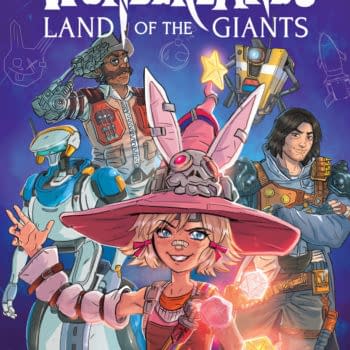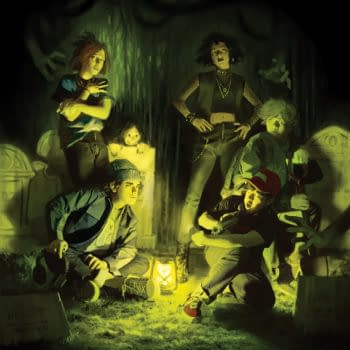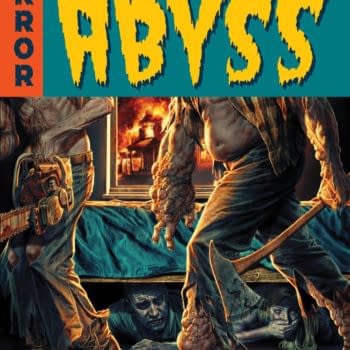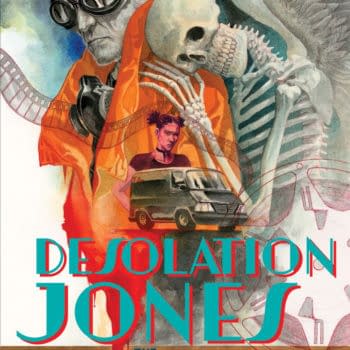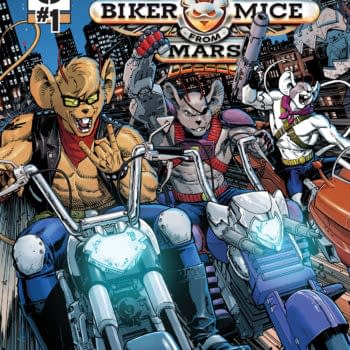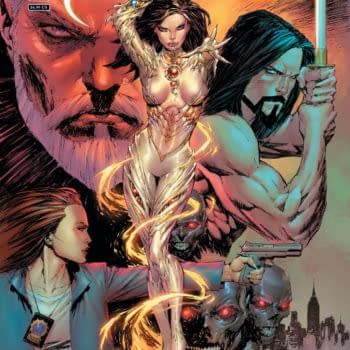Posted in: Comics, Recent Updates | Tagged: Comics, horror comics, kickstarter, Mike Wolfer, The Widow Archives
The Return Of Widow – Mike Wolfer On Horror Comics, Kickstarter, And The Devotion Of Fans
By William Wright
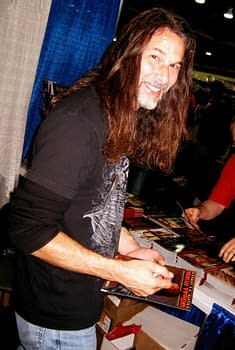
Wolfer recently sat down with Bleeding Cool to discuss bringing the character back into print, the lasting appeal of Widow, returning to self-publishing, and his upcoming Daughters Of The Dark Oracle: The Curse Of Ragdoll mini-series.
William Wright: For those fans that are unfamiliar with Widow give us a brief introduction to her backstory…
Mike Wolfer: Back in my self-publishing days as Ground Zero Comics, I created a black and white, horror mini-series called Widow: Flesh & Blood. It was initially planned to be a single, three-issue, self-contained story of a mad doctor conducting genetic experiments on a secluded, tropical island, with a scary monster, graphic violence, and an adult theme. To my surprise, sales were extremely strong for the first issue, and continued through to the story's conclusion. And the funny thing was, it was selling great despite the fact that no one knew the surprise hook of the story, that the monster responsible for a string of horrific murders on the island was in fact the scientist's seemingly human daughter, and not a creature that had escaped from his lab. In fact, not a single issue featured Emma (the main character) in her spider form, and she didn't appear "spidered-out" until halfway through the last issue. I realized that I was on to something if readers were positively reacting to the story and the character of Emma without knowing her true nature, so sequels soon followed. There were four Widow mini-series in all, and I also published a reprint title called Fangs Of The Widow.

MW: Honestly, I'm not sure I can put a finger on it. It could be a number of things. It might be her physical appearance. In comic book terms, her "costume" is her body. Her spider legs and mandibles are what identify her, which is a little different than so many other characters that are identified by the colors and design of their clothing or armor. She can wear anything, or not wear anything, and people can still say, "That's Widow." Fans might be reacting to her character and story itself, which is filled with unrequited love and a search for an understanding of just what she is. But I'll be totally honest with you- I think a lot of people have a soft spot in their hearts for Widow to this day because of the gore and nudity. When I was creating those stories, it was still the early days of independent comic publishers like Rebel Studios, Chaos! Comics, and London Night Studios, and we were all saying, "The hell with 'safe' books, let's go all-out." I think that kind of rebellious, outlaw mentality is apparent in Widow, and could be why the book has been so attractive to horror fans all these years.
WW: It's been close to 15 years since the character was last seen in a regular title. Has the internet and digital file sharing played a part in new fans being able to discover Widow?
MW: That's probably right on the mark. When readers of my Friday The 13th, Night of the Living Dead, Gravel, Stitched, or Lady Death books Google me, pictures of Widow comics invariably appear, and I know that comic database sites are well-stocked with images and series synopses that give comic fans their first glimpse of Emma. Online comic dealers and eBay stores are also great for spreading the word, simply by listing back issues.
WW: Why bring back Widow now after all these years and fund it through Kickstarter instead of seeking out a publishing deal?
MW: After working strictly for page rates for the last 18 years, it just feels like the right time to once again explore self-publishing. I like the idea of being able to control the direction and flow of my work, to be responsible for every aspect of production all the way down to overseeing lettering placement, working directly with cover colorists, choosing logo colors, everything. I like the idea of knowing that because of the extensive self-promotion that I do, I'll be directly compensated through the sale of variant covers, trade paperbacks, and back issues in stores, online, and at conventions.
My first foray into self-publishing in 20 years was the publication of the Gothic horror The Curse of Ragdoll graphic novel last summer, which was funded through Kickstarter. I wanted to get that story back in print, since very few people had seen or heard of it. I was really proud of that one, and always thought that it deserved a larger audience. So I gave Kickstarter a shot, and was pleasantly surprised by the outpouring of support I got from fans old and new. Because of the success of the campaign and that book, which was available only to Kickstarter backers and mail order customers, I decided to direct all of my energy toward Mike Wolfer Entertainment, and pursue monthly comic releases distributed to comic stores by Diamond Comic Distributors. My flagship title will be Daughters Of The Dark Oracle, which will be published as a string on mini-series featuring characters from the Ragdoll universe. The first, four-issue series will reprint The Curse of Ragdoll in a monthly, comic book format, to be followed by the five-issue Daughters Of The Dark Oracle: Orgy of Vampires.
My publication schedule is now firmly in place and I have plenty of work in front of me, but I also now have the ability to answer the request of so many of my fans, and that's to do trade paperback collections of my Widow work. On March 9, I launched a Kickstarter to fund the production of all four volumes of Widow Archives. I reached my $5,000 goal in just 12 hours, and the campaign runs until April 8, so there's a lot of time left, and a lot of people yet to reach. Backers can receive any or all of the Kickstarter exclusive covers of the Widow Archives along with nude cover variants of each. I'm also offering t-shirts, action figures, and a fifth volume, the Fangs Of The Widow Annual, which serves as an epilogue to the four volume set and brings closure to the entire story. The comic business is an incredibly difficult one, and it's even more difficult to make a profit, but with Kickstarter- and the direct support of fans- the risks of publishing and the risk of losing money is greatly diminished.

MW: It was the best of times, followed unexpectedly and immediately by the worst of times. That whole "Indy Boom" period was incredible, and there was such excitement and creativity exploding everywhere, from so many publishers. If you could slap a "#1" on the cover of a book, it was like printing your own money. Sales were incredible, and the spotlight that suddenly fell on indy publishers brought out the best in some, and the worst in others. It was surreal, really, particularly the conventions. Everyone seemed to be buying everything, which meant that we starving artists were no longer starving; in fact, quite the opposite. And more than a few publishers who experienced that success spent way too much money on things they didn't need. The spending was extravagant, the parties were endless, the drinks were flowing and everyone was laughing all the way to the bank until the "crash." Publishers, retailers, and distributors alike disappeared overnight, and many creators were left without a source of income, many to leave the field entirely and never return. Let me tell you, that was a rude awakening that made us all realize that we were living in a bubble completely fabricated by our own hype and the fervor of fickle speculators. I learned a lot from those days, to be sure, and I'm lucky to have survived it.
WW: This is your fourth Kickstarter project that has been fully funded. To what do your attribute your success so far?
MW: The success of my Kickstarters can be attributed primarily to the devotion of my fans. I tell people all the time that I'm just a regular guy who has a unique talent, and I'm humbled that so many love and follow my work the way that they do, and I think that resonates with a lot of people. They know how devoted I am to what I do, so they return that devotion to me by their continued support. Now, through Kickstarter, they're also putting their hard-earned money on the line to help me give them more of what they love. It's an incredible, symbiotic relationship, and I value each and every one of my fans.
I don't know if a lot of people understand why Kickstarter is so important to comic creators. I alluded to this earlier, about some truths about the comic book industry. Regardless of the size of the company, sales aren't great, which means that it's really difficult to make money, and that means that many publishers are working with bare-bones budgets. Which means that page rates for creators are the first things that get cut. It's a fact of life, it's unavoidable, and it's no one's fault, it's just the way it is. But when you consider how much time and effort go into writing a script or illustrating a page, many of those rates barely equate to minimum wage. Now, if established publishers with advertising budgets, licensed properties, and great name recognition through branding are finding it difficult to make a profit, how can a small, self-publisher hope to succeed? Then there's this angle: People think, "Oh, you're so lucky, you can work at home and draw comics." Okay, I'll admit, it is pretty cool. But if it takes me two months to write and draw a comic, then another month or two to get it to the printer and distributor, then another month to get a check from that distributor… Where's my income coming from? There is none.
Oh- And don't forget, all advertising and printing costs must be paid in advance, months before that check from the distributor with your percentage of the sales arrives. You see where I'm going with this. Unless you've got a wealthy backer or a stash of money in the bank to live off of for half a year while you create your dream project, you can't afford to be a comic book self-publisher. Enter Kickstarter. Suddenly, with the direct and generous support of the people who you're creating your project for, creators like me can generate the funds we need for all of those up-front expenses, and also give ourselves our own page rate, so that we don't starve or go through foreclosure while we're drawing our goofy comic books. Kickstarter is something that could have saved many a publisher back in the '90s, had it existed back then.

MW: Let's all say it together: "Beware of underestimating international shipping fees!" Yeah, that's the big one, that nearly every, single Kickstarter creator will agree with. The only other thing that zinged me was doing a Kickstarter to fund a book that I had not yet illustrated, which was Countess Bathory #1. I'll be delivering that book two months later than anticipated because last fall I was sick and unable to work for nearly two months, which threw my Avatar work horribly behind schedule, thus pushing Countess Bathory back as well. I've been up-front with my Kickstarter backers, though, and the prevailing sentiment is, "Who cares, take your time, make it gorgeous, and when it's ready, it's ready." I'm not going to take advantage of that by pushing back the delivery date any further than I absolutely have to, but I do appreciate their understanding.
WW: What horror property would you love to resurrect from the dead and put your creative stamp on?
MW: Wow, I don't even know where to begin. When you say "property," I immediately think "movies." I was a child of the '70s, so much of my genre tastes are Hammer films, total crap horror/exploitation, slasher films, classic monsters, Toho kaiju, I'm all over the place. Most people would roll their eyes if they saw my DVD collection. I did have the incredible good fortune to work on both FRIDAY THE 13TH and NIGHT OF THE LIVING DEAD at Avatar Press, and would love the opportunity to do more of each. I have an entire F13 mini-series half-written and fully plotted, and a NOTLD story that was rejected by Avatar Press and a few other mid-size publishers that I've converted into a totally new story that I'll self-publish next year with the Mike Wolfer Entertainment label. But if we're dreaming, I'd love to get my hands on THE EVIL DEAD or THE THING FROM ANOTHER WORLD.
WW: What's next for Mike Wolfer in 2015?
MW: That would be Daughters Of The Dark Oracle. After the success of that first Kickstarter for The Curse of Ragdoll, I decided I would continue releasing Ragdoll sequels in graphic novel format, maybe once or twice a year, and fund them through Kickstarter. But what I didn't expect was the amount of attention the first one got from fans and critics. TCOR made several "Best Of" polls for 2014, tying for first place for Best Graphic Novel of the Year in comicattack.net's readers poll, and winning the Best Inking award (also nominated for Best Original Graphic Novel) in the 2014 Ghastly Awards. That really got me thinking that I should expand my scope of distribution because readers are really digging it, and it also bugged me that fans would have to wait 6-9 months between releases. So I've converted my plan to a more traditional approach.
What I'm doing now, as I said earlier, is releasing each Ragdollwidow sequel in a comic "singles" mini-series format first, and collecting them into graphic novels later. Even though TCOR is out there as a mail-order trade paperback, I'll be reaching a lot of new readers through comic stores, so they're going to need to see that first Ragdoll story because it's the introduction of the whole series concept and the beginning of a huge saga. Fans have asked me about the title change, which I think was necessary. Ragdoll is the central character in all of the stories I have planned, but each new mini-series will be introducing at least one or two other supernatural, female characters, which is reflected in the title, Daughters Of The Dark Oracle. In fact, the first issue of Daughters Of The Dark Oracle features not only Ragdoll, but Countess Bathory, The Wolfwoman, and The Siren, along with a new character who will be the force that ties them all together.
I can't express how excited I am about this project. It's rejuvenating in so many respects, and what readers will be seeing is my absolute love of the genre, and I hope that everyone is okay with the total '70s, retro feel of the story itself, the way it's presented, and the packaging. My inspiration for the content comes from my love of Hammer films, and the black and white/gray tone ink wash interior art is my homage to Warren Publishing Company's Eerie, Creepy, and Vampirella magazines, which were what inspired me to become a comic creator. I'm also getting to work with my girlfriend Natalie Jane, who is lettering the series, and Ceci de la Cruz, who is providing all of the digital color painting on all of the covers. The first issue of Daughters Of The Dark Oracle: The Curse Of Ragdoll will be listed in the May issue of PREVIEWS, and will hit stores in July, and I'll be running a Kickstarter campaign to fund the series, launching on April 20, 2015. Anyone who wants more information or peeks at upcoming art can find everything they need and more on the official Facebook page, www.facebook.com/thecurseofragdoll, and previous releases, art prints, Oracle Cards, and t-shirts can be found at www.ragdollonline.com.
Mike Wolfer is currently running a Kickstarter campaign for Widow Archives online here. The project is currently funded and attempting to fund stretch goals.
William Wright (aka BigJ) has been working as a freelance writer since the days when magazines were actually physically printed. William actively writes about comics for Bleeding Cool, Bloody-Disgusting, and is a huge fan of all things horror.










